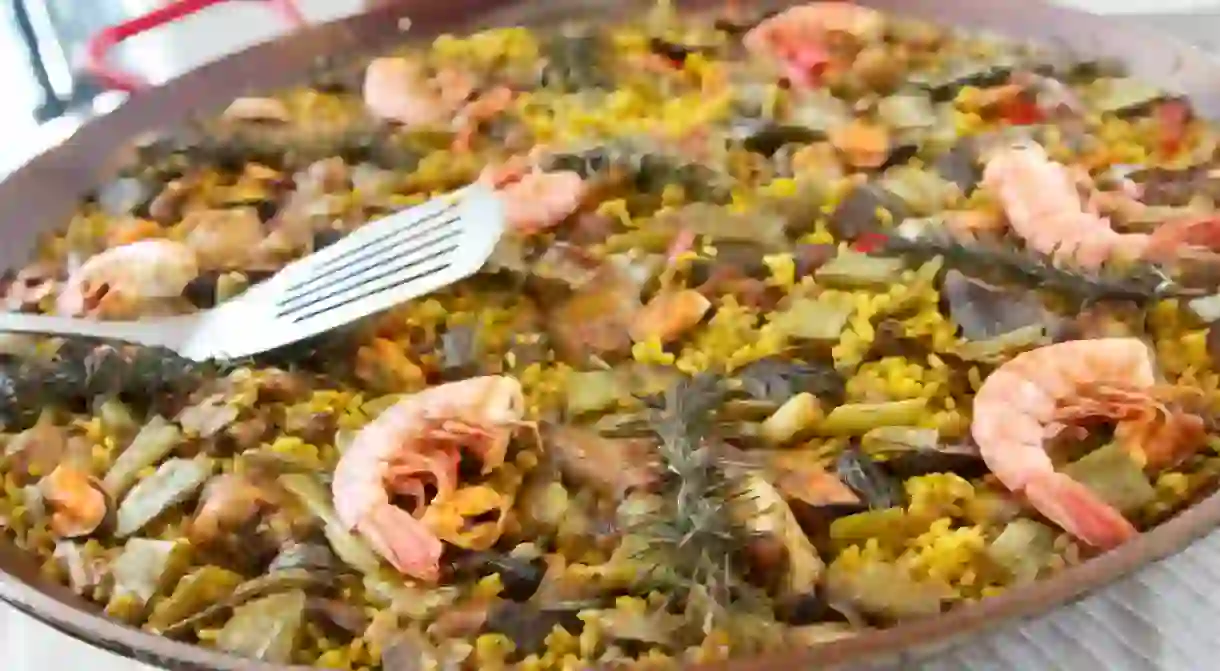Everything You Need To Know About Paella

Without a doubt one of Spain‘s most well-known and well-loved culinary delights, paella is a traditional rice-based dish Here’s our guide to everything you need to know about this Spanish classic.
The Origins of Paella
Although paella is by and large considered one of Spain’s most emblematic dishes, it, in fact, originates from the region of Valencia, on the Eastern coast of the country. Irrigation systems first developed by the Romans improved throughout the centuries, leading to rice being a staple in the diet of the area by the 15th century. The origin of paella as we now know it is believed to be open-air meals cooked around the lake Albufera in Valencia, in which one of the main ingredients was water vole.
As eating habits evolved and became slightly more sophisticated, Valencians started adding other types of meat to their rice dishes such as rabbit, chicken or duck, as well as butter beans, paprika and saffron. Although this mostly meat-based recipe is considered the original Valencian paella, because of the areas location by the shores of the Mediterranean, a fish-based variant rapidly emerged as the dish’s popularity spread. Traditionally, seafood paella would always be served with the seafood in its shell, although a more luxurious version, the paella del senyoret, required removing the seafood from its shell before presenting it to the table.

As for the origins of the name ‘paella,’ it is quite simply the Catalan word for ‘pan’ and as such is used by Catalan speakers to refer to all kinds of pans, not just the typical thin-based pans used in the preparation of the eponymous dish. It appears that it wasn’t until 1840, when a local newspaper published an article on the regional speciality, that the word ‘paella’ was used to refer to the dish itself, not just the pan in which it was prepared.
The Preparation of Paella
One of the most important components in the preparation of the dish is, of course, the ‘paella’ or pan itself, which is typically large (sometimes huge), round and thin-based. Nowadays, paella dishes come in all sorts of different materials and shapes to adapt to the needs of modern kitchens. The early paella dishes and more traditional ones these days are slightly convex, not flat-bottomed, which is believed to help with the preparation of one of the first stages of the dish: the sofregit, or sofrito in Spanish, (see below). Because paella would traditionally have been cooked over an open fire, the question of heat distribution on a convex pan would not have been a problem in the same way as it would be with today’s induction and electric hobs.

As mentioned above, one of the very first stages of the preparation of the dish is the cooking of the sofregit, a sauce composed principally of tomatoes, onion and olive oil, which serves as the base of many Spanish and Latin American food preparations. A good sofregit is considered essential to a good paella, and each household will usually have their own special recipe and method of preparation. Recipes for paella are many and varied, with each region, town or household likely to have their own, and each different one is, of course, better than all the rest. Referring to a well-trusted local recipe book is probably the best place to start if learning directly from someone is not an option.
Of course, fresh ingredients of good quality are of prime importance when preparing to cook paella, but perhaps above the importance of those ingredients is the choice of rice. In order for the rice to do what is expected of it in the course of the preparation of the dish, it needs to be short-grained, slightly rounded, able to absorb liquid but also retain a certain firmness in cooking. There is nothing more likely to ruin an otherwise delicious paella than a mushy rice.
The Eating Of The Paella
After hours of careful preparation comes the much-awaited moment of reward: the meal. One sign of a good paella is the depth of the rice-based preparation in the pan: Valencians say that it should be no more than ‘un ditet‘ or ‘a little finger.’ The reason being that as the stock tends to run to the bottom of the pan, the grains of rice in contact with the pan surface are those with the most flavor.

Indeed, the bottom layer of rice of a paella, when it is well done, is the most coveted part of the dish and has its own special name: the socarrat. In order to deserve that name, the rice needs to be slightly crispy and is achieved by turning up the heat under the pan during the final stages of the cooking until the dish starts to give off a slightly toasted smell and you can hear the rice begin to crackle. Don’t make the rookie mistake of discarding this as ‘burnt rice’ – that’s exactly what your more experienced dining partners would want you think.
Finally, if there is one last thing to know about paella, it is that, from its very preparation to the final act of enjoyment, it is a dish designed for sharing and for bringing people together. And that, that moment in which everyone prepares to tuck in, equipped with only a smile and a spoon, is perhaps the most important element of a good paella.













